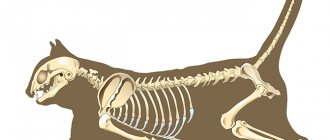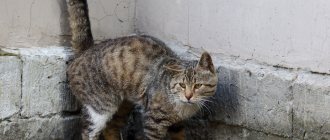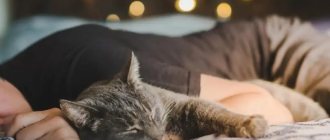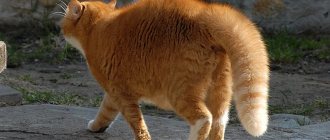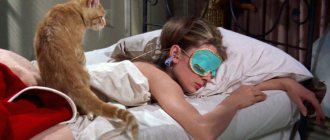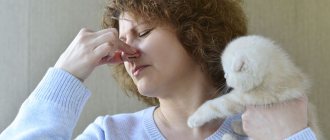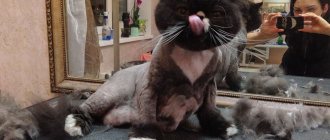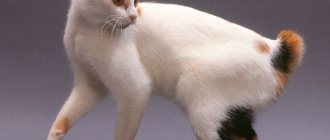Opinion of zoopsychologists
A cat, no matter how long it is next to a person, remains at heart a predator driven by hunting instincts. When a little kitten plays with his tail, he learns to track, chase, and catch nimble little furry prey. Chasing the tail is the first step to successful mouse hunting. The baby catches the tail of his mother and his brothers and sisters with equal enthusiasm.
A kitten is born with instincts “written” in its genes. He plays in order to:
- study;
- hone the skills of a hunter;
- improve mentally and physically;
- maintain physical fitness.
Desire to hunt and play. In conditions of limited space, domestic cats cannot realize the hunting instinct and exchange the missing object for an analogue (according to the cat's understanding). After all, the fluffy moving tail looks so much like a mouse.
Animal psychologists consider this behavior to be the norm in kittens. In adult cats, chasing their own tail is also a favorable sign. Only a calm cat happy with its life has the desire to play.
Owner actions.
If the owner is concerned about the cat's desire to chase its tail, it is worth taking care of the toys.
The animal needs to play, and there is only one object at its disposal - its tail. By buying a pet a fur mouse, a ball or a feather tassel and spending time playing with the pet, the owner will not only keep him busy. Researchers say that playing together strengthens the psycho-emotional bond between humans and pets.
How to react when a cat is chasing its tail
If you catch a cat chasing its tail, it is better not to react - the reaction may increase its behavior. Trying to stop your cat from chasing its tail can increase stress levels and make the underlying problem worse.
You can then try to keep track of the frequency and type of chasing your cat does with her tail, such as how often she chases her tail and whether it is always the same, such as aggressive or playful.
If the behavior persists and matches some of the most concerning signs listed above, it is time to contact your veterinarian. They will be able to help diagnose your cat's problems and find possible solutions.
Breed characteristics of character and temperament
Adult purrs of some breeds will never run after their tail due to the characteristics of character and temperament that were built into them by breeders.
"Calm and only calm." Calm, balanced cats include representatives of certain breeds:
- Burmilla;
- Siberian;
- Norwegian forest;
- Burmese;
- American Curl;
- British;
- Russian blue.
They have a very strong psyche, so if a calm cat starts chasing its tail, you should take it to the vet.
Funny "annoyers". Representatives of other breeds are sociable, affectionate, and sometimes intrusive in expressing their feelings:
- Siamese;
- oriental;
- German Rex;
- Bengali;
- Canadian Sphynx.
Such cats not only give their love to their owner, but also require attention, care, and affection in return. If a cat of this breed starts playing with her tail, then she:
- wants to attract attention that she lacks;
- wants to please the owner, because she noticed that such behavior makes him laugh;
- wants to distract the owner from bad thoughts and improve his mood.
You should play with such a cutie, caress her, showing your love.
Unapproachable proud people. Powerful, proud cats from the breed:
- Maine Coon;
- British;
- Persians;
- Kurilian and Japanese bobtail.
They will most likely consider it beneath their dignity to entertain the owner, but behavior unusual for such proud people can serve as a signal of illness or mental discomfort, stress.
It's not just about the breed... Of course, it is wrong to equate character with breed. Character depends on many factors, including upbringing, environment, and past experiences. Temperament also leaves its mark on character. A sanguine or choleric cat is more likely to play with its tail than a phlegmatic or melancholic cat. A caring owner must study the individual characteristics of his pet and respond if his behavior does not correspond to the norm.
What to do if your cat can't give birth
If the animal is unable to give birth on its own, even under the influence of Oxytocin, the doctor may resort to a last resort - a caesarean section. Many owners are afraid of surgery, but it is considered the safest method of treating fetuses without risking the life of the animal.
Attention! Caesarean section can only be performed in a clinical setting, as this requires sterile conditions, special instruments, medications and a resuscitation kit if necessary.
Physical problems
Veterinarians focus on the health status of the pet if its behavior is a symptom of disease. The reason for chasing your own tail can be pain, itching, burning caused by:
- parasitic diseases – worms, fleas, ticks;
- inflammation of the paraanal glands;
- anal herbs;
- constipation;
- skin diseases;
- allergies to food;
- tail injuries - fracture, bites of other animals, compression, torn ligaments;
- mental disorders, for example, the consequences of brain injuries and infections.
Trying to get rid of painful sensations, the cat diligently licks and chews its tail, until bald spots and wounds form.
It is necessary to pay attention to such behavior in a timely manner.
Also watch the video why a cat chases its tail:
Blocked anal glands
The reason why a cat twitches its tail and runs can be a blockage and inflammation of special glands. They are located in the anus and contain a secretion with a pungent odor. When the substance in the glands cannot come out along with the feces, the inflammatory process begins.
The cat experiences pain and itching. She gets angry and tries to influence the sore spot by biting her tail. Cleaning the glands can help in the situation. However, before agreeing to this procedure, the problem must be diagnosed.
If you clean healthy glands, there is a high probability that the procedure will have to be performed regularly.
When to urgently contact a veterinarian
After giving birth, the cat should gradually recover. She gains strength, she begins to move around and feed her offspring.
But there are cases when the animal becomes lethargic for a long time, and discharge forms in the genitals. The pet refuses to eat. This is a reason to contact a veterinarian. The cat's body temperature may rise greatly and convulsions may begin. All this can lead to her death if timely treatment is not started.
Childbirth is a natural process for cats, but in some cases it is complicated. Therefore, the owner needs to know what to do during this period. This applies to any pet, be it a purebred British cat or an ordinary yard cat. Complications may occur during the first or each subsequent birth.
Read: 50
Injury
The cause of tail chasing may be due to injury. Young kittens are constantly jumping. This leads to a bruise or fracture. By trying to catch the tail, the kitten signals a problem.
If an adult cat is chasing its tail, the cause may be a pinched nerve. To find out the cause, you need to meet with a veterinarian. An x-ray will help clarify the diagnosis.
© shutterstock
To please the owner
There is an unlikely chance that your pet may be chasing its tail in circles to get its owner's attention. Perhaps one day the kitten was practicing catching imaginary prey. The owner saw this and rewarded him with attention, delicious food, and praise. The kitten remembered this moment and continues to perform the same actions even when it has matured.
The owner should not encourage such behavior. In excitement, a pet can injure itself. When you see a running kitten, it is better not to grab the camera to film what is happening, but to show it to the veterinarian. A funny sight may hide a serious problem.
Functions
Cats use their tail quite actively throughout their lives. Sometimes a cat's tail can be as important to your cat as his main pride - his whiskers. The entire tail is practically permeated with the finest nerve endings, which are directly connected to the central nervous system and allow your pet to feel better in the environment.
Balance
Quite often you can hear stories about a cat falling from a great height, but remaining completely unharmed. One of the reasons for this amazing ability is balancing with its tail. During a jump or fall, the pet's body completely maintains its balance, which allows the animal to calmly land on all four paws.
When hunting, the tail, almost like a steering wheel, allows the animal to make various kinds of turns. The tail rotates very actively during all body movements of the animal, giving its body a certain direction.
Thermoregulation
During the summer heat, a cat uses its tail as a fan - few ordinary people know about this interesting fact. Thus, the animal lowers its own body temperature and saves its body from possible overheating. And if the cat’s body does not have enough heat, the pet will begin to curl into a compact ball, and at the same time it will cover its nose and eyes with its tail - this is done to reduce heat loss.
Intimidating enemies
When a cat is seriously frightened, its fur will immediately stand on end, and its maximally fluffy tail will be raised high and comically arched. With this pose, the pet tries to appear much larger than it actually is. Many representatives of the animal world resort to a similar trick (to create a visual illusion of increased body size) in order to avoid a potential collision and intimidate enemies.
In the wild, any bite can, in principle, become fatal; for this reason, even among close relatives, there are special rituals that allow you to determine who is in charge without a fight. For example, many cats will prefer to spend a long period of time howling in a surprisingly creepy manner and brazenly hovering around each other before actually engaging in a fight. A luxurious, large fluffy tail in such a situation will help its owner gain a much-needed advantage in strength.
Means of communication
It is worth paying attention to the fact that cats use their tail as one of the devices actively used for full communication. Remember how your pet, in moments of serious irritation, suddenly begins to shake its tail or it twitches strongly to the sides, how it fluffs up its pride in the form of a tail and raises it if something unfamiliar frightens the animal.
During its hunt, the cat lowers its tail as low as possible and tries to keep it parallel to the surface of the earth. In certain cases, you can even see a slight twitching of the tip of the tail - in this simple way the animal tries to restrain its increasing excitement.
It is worth explaining how those pets that are born completely without tails or are left without their tail due to misfortune or the stupid will of their owners manage without such an important element as a tail. Those who accidentally lose their tail may lose their graceful movement and confidence in their gait for a long time and will have to learn to live without such a convenient balancing tool.
Health indicator
Based on the condition of the coat on the tail, you can learn about the diseases that a particular pet has. If a cat loses fur in the sacral area at the very base of the tail, then the pet clearly does not have enough vitamins and various microelements in its body, which can be corrected with a fortified diet. Hair loss on this part of the body may also indicate the presence of lichen, fungus, lice or allergies on the animal’s body.
Cats also need a tail for comfort and play. An animal that wants to exercise and have fun, in those moments when nothing within reach can attract its attention, can concentrate entirely on its own tail. After all, he is actively moving all the time, and this perfectly imitates a potential prey that can be hunted.
When a cat chases its tail and then catches it, it begins to understand that it is just a part of its own body, and not an enemy or prey. After realizing this fact, as a rule, the animal begins to intensively care for its tail. When playing, a cat will never harm itself, so you shouldn’t stop it from playing with its tail.

